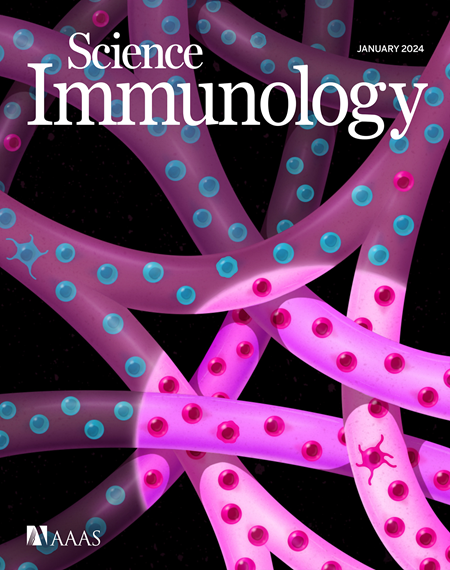线性个体发生解释了小鼠初始、记忆和肿瘤浸润调节性T细胞的发展
IF 16.3
1区 医学
Q1 IMMUNOLOGY
引用次数: 0
摘要
调节性T细胞(T reg细胞)是适应性免疫和抗肿瘤免疫病理生理的重要调节因子。T细胞既在胸腺发育过程中产生,也由外周常规T细胞诱导产生。这些不同的途径在健康和疾病中如何促进循环T细胞的稳态仍不清楚。我们使用多个命运映射鼠标系统和建模来解决这个问题。初始T细胞和效应/记忆(EM) T细胞表现出不同的动力学,但在整个生命过程中都不断地通过从头生成来补充。循环EM T reg细胞的主要前体是幼稚胸腺T reg细胞,而不是传统的T细胞,这是一个由自身而不是外来抗原识别驱动的过程。使用相同的命运报告器和三种肿瘤模型,我们证明浸润性T regg细胞特异性地来自先前存在的EM T regg细胞。总之,我们定义了T细胞从胸腺到EM的线性个体发生,由自身抗原识别驱动,然后产生肿瘤浸润性T细胞。本文章由计算机程序翻译,如有差异,请以英文原文为准。
A linear ontogeny accounts for the development of naive, memory, and tumor-infiltrating regulatory T cells in mice
Regulatory T cells (Treg cells) are critical regulators of adaptive immunity and the pathophysiology of antitumoral immunity. Treg cells are both generated during thymic development and induced from peripheral conventional T cells. How these distinct pathways contribute to the homeostasis of circulating Treg cells in health and disease remains unclear. We addressed this question using multiple fate-mapping mouse systems and modeling. Naive and effector/memory (EM) Treg cells exhibit distinct dynamics but are both continuously replenished by de novo generation throughout life. The predominant precursors of circulating EM Treg cells are naive thymic Treg cells and not conventional T cells, a process driven by self rather than foreign antigen recognition. Using the same fate reporters and three tumor models, we demonstrate that infiltrating Treg cells specifically derive from preexisting EM Treg cells. In summary, we define a linear ontogeny of Treg cells from the thymus to EM, driven by self-antigen recognition, that then gives rise to tumor-infiltrating Treg cells.
求助全文
通过发布文献求助,成功后即可免费获取论文全文。
去求助
来源期刊

Science Immunology
Immunology and Microbiology-Immunology
CiteScore
32.90
自引率
2.00%
发文量
183
期刊介绍:
Science Immunology is a peer-reviewed journal that publishes original research articles in the field of immunology. The journal encourages the submission of research findings from all areas of immunology, including studies on innate and adaptive immunity, immune cell development and differentiation, immunogenomics, systems immunology, structural immunology, antigen presentation, immunometabolism, and mucosal immunology. Additionally, the journal covers research on immune contributions to health and disease, such as host defense, inflammation, cancer immunology, autoimmunity, allergy, transplantation, and immunodeficiency. Science Immunology maintains the same high-quality standard as other journals in the Science family and aims to facilitate understanding of the immune system by showcasing innovative advances in immunology research from all organisms and model systems, including humans.
 求助内容:
求助内容: 应助结果提醒方式:
应助结果提醒方式:


